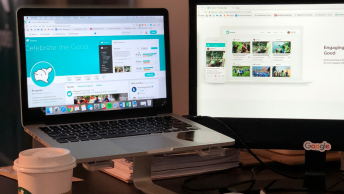While the ad tech age offers exciting innovations in digital marketing, it’s important not to let your brand get lost in the bells and whistles. Here’s why you need to focus on brand consistency in the face of ad tech.
The Ad Tech Age is in Full Swing
The digital marketing landscape is an exciting place. Artificial intelligence and automation can do a lot of work for advertisers in the digital space. This can benefit digital brands by helping to strengthen their ad campaigns and give them a high tech edge on competitors.
However, just because these new tools are exciting and useful, does not mean that they don’t have their pitfalls. When used incorrectly, they can take a big toll on your brand consistency. Ad tech issues can possibly damage the integrity of your digital brand and even get you into trouble. Let’s explore the benefits and risks of ad tech and see how you can avoid potentially sticky situations.
The Cons of Ad Tech
Ad tech allows your brand to cast a wide advertising net. While this looks good on paper, it removes your agency in the exact placement of these ads. This can potentially be a digital branding nightmare for several reasons.
SEE ALSO: What Is Digital Branding
For one thing, it makes it impossible for you to know exactly where your ads are being placed. In fact, they could even miss your intended audience entirely, due to re-brokering. Sometimes a publisher will forward your ad to an affiliate, and your ad will appear there instead. Unfortunately, there is no way to know exactly where that is.

As you have no control over where your ads are placed, they could ultimately appear alongside questionable content or content that does not align with your brand’s image and values. This can lead to a huge lack of brand consistency and possibly a PR nightmare.
In one infamous incident, several major advertisers were forced to pull their ads from Youtube after it became known that these ads were appearing alongside videos promoting hate speech. Verizon, for example, had ads appearing alongside the videos of a hate preacher whose teachings may have inspired the murder of a politician in Pakistan.
It is important to know how to use programmatic video ads correctly so that it promotes your brand without harming your brand consistency. But, how can you do this?
How to Create a Brand Safety Policy
It’s no secret that exposure to questionable content can damage a brand. In fact, over 75% of marketers think so. Here are some steps you can take to create a safe advertising campaign and maintain brand consistency and identity in the ad tech age.
SEE ALSO: How to Create a Brand Identity Guide
1. Using Digital Content Labels
Digital content labels classify the type of audiences that are suitable for a piece of content. They are roughly comparable to movie ratings such as G, PG-13, and R. Here is a breakdown of Google’s digital content labels:
For example, if your ad is targeting adults or contains adult themes, you don’t want it appearing alongside content for little kids. This is one way to help maintain brand consistency and avoid uncomfortable situations.
2. Make a List of Negative Keywords
You can also blacklist keywords that you do not want your brand associated with. That way your ads will not appear alongside content which uses those keywords. This can be both moral, but also very practical.
The English language has many words which are similar, and if you are not careful your ad could end up showcased alongside a lot of different kinds of content. Google allows a list of up to 5,000 negative keywords, so don’t be afraid to make full use of this feature.
3. Do the Same for Sensitive Categories
As well as negative keywords, make a list of sensitive categories. These include categories of content which you don’t want your ads to appear attached to. Depending on your ad and brand identity, these categories will vary.
Many digital brands opt for blacklisting categories such as hate speech, politics, sexually suggestive content, or violence. However, these things are often difficult to define via algorithm, and content can sometimes slip through the cracks. So, you will have to take extra care.
4. Blacklist Websites
Create a list of sites that would potentially damage the reputation of your digital brand if your ads were to appear there. This can be time-consuming, and it would be impossible to list them all, but at least getting down a solid list of highly trafficked sites you want to blacklist is key. For example, you may not want your ads on sites known for click bait and false news.
For Brand Consistency, Focus on Quality and Not Quantity
Ad tech can allow you to virtually paper the internet with your ads, and it can be tempting to want to cast as wide of a net as possible. However, overextending your reach can negatively affect your brand consistency. This might do more harm than good.
Instead, you need to cultivate a digital marketing strategy which focuses on quality placements. Don’t just have your ads appear on a bunch of random websites without rhyme or reason.
SEE ALSO: 3 Tips for Digital Branding Optimization
The randomness of ad placement is what caused a mass exodus of major advertisers from YouTube. As explained by Daisuke Wakabayashi and Sapna Maheshwari at the New York Times:
“More than 400 hours of content are uploaded to YouTube every minute, and while Google has noted that it prevents ads from running near inappropriate material ‘in the vast majority of cases,’ it has proved unable to totally police that amount of content in real time. And that has advertisers increasingly concerned.”
Ultimately, even in the fast-paced and constantly evolving ad tech age, automation can only do so much. You know what is right and appropriate for your brand and need to be active in ensuring your ads are shown beside the right content. Artificial intelligence does not understand your digital brand, and cannot maintain the integrity of it with no guidance.
Maintaining Brand Consistency in the Ad Tech Age
Ad tech is a powerful tool, but like all tools, it has its limits. After all, a blender is a great kitchen tool, but if you don’t put the lid on before you start blending, you will have a mess in your kitchen.
And effective digital brand management is far more complex and strategic than making a smoothie.
SEE ALSO: Digital Brand Management in 30 Minutes a Day
Here are the steps you need to take to use ad tech the right way and hopefully stay out of messy situations.
- Create a brand safety policy
- Define your target audience
- Aim for quality placements, rather than quantity
In which ways do you think ad tech most needs to improve? Comment below…













